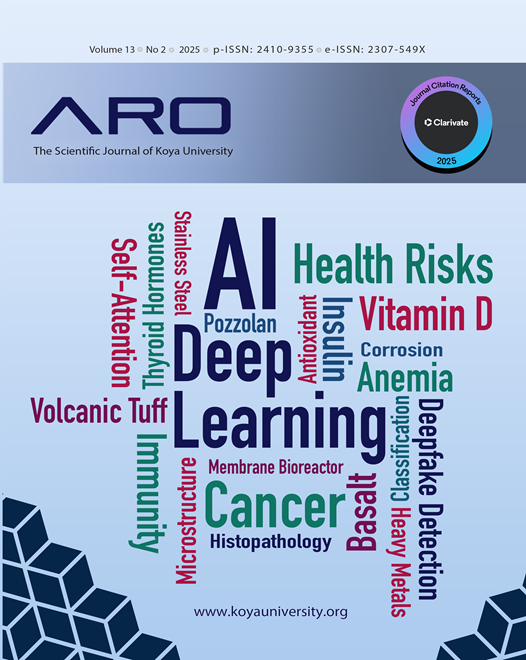Evaluation of 3D-CRT Treatment Planning Techniques for Breast Cancer
A Comparative Study of Collapsed Cone and Monte Carlo Algorithms Using New Quality Indices
DOI:
https://doi.org/10.14500/aro.12195Keywords:
3D-CRT techniques, Collapsed cone and Monte Carlo algorithms, Dose-volume histogram, Planning Target Volume, Quality plan indicesAbstract
This study compares the collapsed cone (CC) and Monte Carlo (MC) algorithms for radiation treatment planning for lumpectomy of the chest wall. The aim is to evaluate how these algorithms affect dose distribution and plan quality improve treatment outcomes. Fifteen patients received left breast chest wall radiation using the 3D-conformal radiotherapy (3D-CRT) technique with CC calculation. Then plans were subsequently recalculated using the MC algorithm on the same treatment planning system. Dosimetric parameters assessed included the planning target volume (PTV), homogeneity index (HI), and conformity index. In this research, new plan quality indicators named index of achievement, index of hotness, and index of coldness were also evaluated. Organs at risks (OARs) analyzed included the ipsilateral lung, contralateral breast, heart, and spinal cord, and their data were retrieved from the dose-volume histogram (DVH) and compared among algorithms. The results indicated that both algorithms effectively covered PTV. The MC algorithm improved HI and reduced the DVH high dose to the prescribed dose. Interestingly, the CC algorithm resulted in lower mean dose to OAR, particularly the heart and ipsilateral lung, suggesting better OAR sparing. The new quality indexes, the MC algorithm demonstrated superior “index of achievement” values, indicating improved dose painting and better dose conformity within the target. In addition, the MC showed a sharper dose falloff outside the PTV, thereby improving target coverage and overall plan quality. In conclusion, the MC algorithm provides enhanced dose homogeneity and better target coverage quality, while the CC algorithm offers improved OAR protection.
Downloads
References
Abdulkareem, N.K., and Hassan, F.F., 2020. Half beam technique in patient with left breast cancer and evaluate its dosimetry parameters from dose-volume histograms. Medico Legal Update, 20(2), p.281.
Alsaihaty, Z., Manan, H.A., Sabarudin, A., and Yahya, N., 2024. Hybrid treatment planning for chest wall irradiation utilizing three-dimensional conformal radiotherapy (3DCRT), intensity-modulated radiation therapy (imrt), and volumetric modulated arc therapy (VMAT): A systematic review. Cureus, 16(5), p.e59583. DOI: https://doi.org/10.7759/cureus.59583
Aras, S., İkizceli, T., and Aktan, M., 2019. Dosimetric comparison of three-dimensional conformal radiotherapy (3D-CRT) and intensity modulated radiotherapy techniques (IMRT) with radiotherapy dose simulations for left-sided mastectomy patients. European Journal of Breast Health, 15(2), pp.85-89. DOI: https://doi.org/10.5152/ejbh.2019.4619
Bentzen, S.M., Constine, L.S., Deasy, J.O., Eisbruch, A., Jackson, A., Marks, L.B., Ten Haken, R.K., and Yorke, E.D., 2010. Quantitative analyses of normal tissue effects in the clinic (QUANTEC): An introduction to the scientific issues. International Journal of Radiation Oncology Biology Physics, 76(3), pp.S3-S9. DOI: https://doi.org/10.1016/j.ijrobp.2009.09.040
Bhushan, M., Tripathi, D., Yadav, G., Kumar, L., Chowdhary, R.L., Pahuja, A.K., Suresh, T., Shukla, S.K., and Mitra, S., 2021. Feasibility of monte-carlo algorithm in comparison with collapse-cone dose calculation algorithm of a commercial treatment planning system in the presence of high-density metallic implant: A dosimetric study. Journal of the Egyptian National Cancer Institute, 33, p.2. DOI: https://doi.org/10.1186/s43046-020-00057-x
Bisello, S., Cilla, S., Benini, A., Cardano, R., Nguyen, N.P., Deodato, F., Macchia, G., Buwenge, M., Cammelli, S., Wondemagegnehu, T., Uddin, A.F.M.K., Rizzo, S., Bazzocchi, A., Strigari, L., and Morganti, A.G., 2022. Dose-volume constraints for organs at risk in radiotherapy (CORSAIR): An “all-in-one” multicenter-multidisciplinary practical summary. Current Oncology, 29(10), pp.7021-7050. DOI: https://doi.org/10.3390/curroncol29100552
Carrie, C., Ginestet, C., Bey, P., Aletti, P., Haie-Meder, C., Briot, E., Resbeut, M., Coste, G., Chauvel, P., and Brassard, N., 1995. Conformal radiation therapy. Federation nationale des centres de lutte contre le cancer (FNCLCC). Bulletin du Cancer, 82(5), pp.325-330.
Dashnamoorthy, S., Rajamanickam, K., Jeyasingh, E., Pandey, V.P., Nachimuthu, K., Ahmed, I., and Venkatraman, P., 2022. Comparison of dose statistics of intensity-modulated radiation therapy plan from varian eclipse treatment planning system with novel python-based indigenously developed software. Progress in Medical Physics, 33(3), pp.25-35. DOI: https://doi.org/10.14316/pmp.2022.33.3.25
Fuentes, J.D.B., Morgan, E., De Luna Aguilar, A., Mafra, A., Shah, R., Giusti, F., Vignat, J., Znaor, A., Musetti, C., Yip, C.H., Van Eycken, L., Jedy-Agba, E., Piñeros, M., and Soerjomataram, I., 2024. Global stage distribution of breast cancer at diagnosis: A systematic review and meta-analysis. JAMA Oncology, 10(1), pp.71-78. DOI: https://doi.org/10.1001/jamaoncol.2023.4837
Goss, M., Champ, C., Trombetta, M., Shamsesfandabadi, P., Demartino, V., Wegner, R., Beriwal, S., and Eisen, V., 2023. The comparison of collapsed cone and monte carlo algorithms in tangential breast planning. Journal of Radiotherapy in Practice, 22, p.e94. DOI: https://doi.org/10.1017/S1460396923000146
Huang, J.Y., Followill, D.S., Wang, X.A., and Kry, S.F., 2013. Accuracy and sources of error of out‐of field dose calculations by a commercial treatment planning system for intensity‐modulated radiation therapy treatments. Journal of Applied Clinical Medical Physics, 14(2), p.4139. DOI: https://doi.org/10.1120/jacmp.v14i2.4139
Kim, S.J., Kim, S.K., and Kim, D.H., 2015. Comparison of pencil-beam, collapsed-cone and monte-carlo algorithms in radiotherapy treatment planning for 6-MV photons. Journal of the Korean Physical Society, 67, pp.153-158. DOI: https://doi.org/10.3938/jkps.67.153
Lee, S., Cao, Y.J., and Kim, C.Y., 2015. Physical and radiobiological evaluation of radiotherapy treatment plan. In: Evolution of Ionizing Radiation Research. IntechOpen, London. DOI: https://doi.org/10.5772/60846
Liu, H., Chen, X., He, Z., and Li, J., 2016. Evaluation of 3D-CRT, IMRT and VMAT radiotherapy plans for left breast cancer based on clinical dosimetric study. Computerized Medical Imaging and Graphics, 54, pp.1-5. DOI: https://doi.org/10.1016/j.compmedimag.2016.10.001
Marks, L.B., Yorke, E.D., Jackson, A., Ten Haken, R.K., Constine, L.S., Eisbruch, A., Bentzen, S.M., Nam, J., and Deasy, J.O., 2010. Use of normal tissue complication probability models in the clinic. International Journal of Radiation Oncology Biology Physics, 76(3), pp.S10-S19. DOI: https://doi.org/10.1016/j.ijrobp.2009.07.1754
Menzel, H.G., 2012. The international commission on radiation units and measurements. Journal of the ICRU, 12(2), pp.1-2. DOI: https://doi.org/10.1093/jicru_ndv019
Murshed, H., 2024. Fundamentals of Radiation Oncology: Physical, Biological, and Clinical Aspects. Elsevier, Netherlands. Palma, D.A., Verbakel, W.F., Otto, K., and Senan, S., 2010. New developments in arc radiation therapy: A review. Cancer Treatment Reviews, 36(5), pp.393-399. DOI: https://doi.org/10.1016/j.ctrv.2010.01.004
Park, Y.K., Park, S., Wu, H.G., and Kim, S., 2014. A new plan quality index for dose painting radiotherapy. Journal of Applied Clinical Medical Physics, 15(4), p.4941. DOI: https://doi.org/10.1120/jacmp.v15i4.4941
Petrova, D., Smickovska, S., and Lazarevska, E., 2017. Conformity index and homogeneity index of the postoperative whole breast radiotherapy. Open Access Macedonian Journal of Medical Sciences, 5(6), pp.736-739. DOI: https://doi.org/10.3889/oamjms.2017.161
Prabhakar, R., Ganesh, T., Rath, G.K., Julka, P.K., Sridhar, P.S., Joshi, R.C., and Thulkar, S., 2009. Impact of different CT slice thickness on clinical target volume for 3D-conformal radiotherapy. Medical Dosimetry, 34(1), pp.36-41. DOI: https://doi.org/10.1016/j.meddos.2007.09.002
Pyakuryal, A., Myint, W.K., Gopalakrishnan, M., Jang, S., Logemann, J.A. & Mittal, B.B.J.J.O.a.C.M.P., 2010. A computational tool for the efficient analysis of dose‐volume histograms for radiation therapy treatment plans. Journal of Applied Clinical Medical Physics, 11(1), pp.137-157. DOI: https://doi.org/10.1120/jacmp.v11i1.3013
Rancati, T., Wennberg, B., Lind, P., Svane, G., and Gagliardi, G., 2007. Early clinical and radiological breast cancer radiation pulmonary complications following therapy: NTCP fit with four different models. Radiotherapy and Oncology, 82(3), pp.308-316. DOI: https://doi.org/10.1016/j.radonc.2006.12.001
Rastogi, K., Sharma, S., Gupta, S., Agarwal, N., Bhaskar, S., and Jain, S., 2018. Dosimetric comparison of IMRT versus 3DCRT for post-mastectomy chest wall irradiation. Radiation Oncology Journal, 36(1), pp.71-78. DOI: https://doi.org/10.3857/roj.2017.00381
Saddik, M.Z., and Hassan, F.F., 2023. Intensity Modulated Radiation and Volumetric Modulated Arc Therapies in Breast Cancer. Journal of Medicinal and Chemical Sciences, 6, pp.1925-1934.
Shaverdian, N., Tenn, S., Veruttipong, D., Wang, J., Hegde, J., Lee, C., Cao, M., Agazaryan, N., Steinberg, M., Kupelian, P., and Lee, P., 2016. The significance of PTV dose coverage on cancer control outcomes in early-stage non-small cell lung cancer patients treated with highly ablative stereotactic body radiation therapy. The British Journal of Radiology, 89(1059), p.20150963. DOI: https://doi.org/10.1259/bjr.20150963
Shaw, E., Kline, R., Gillin, M., Souhami, L., Hirschfeld, A., Dinapoli, R., and Martin, L., 1993. Radiation therapy oncology group: Radiosurgery quality assurance guidelines. International Journal of Radiation Oncology Biology Physics, 27(5), pp.1231-1239. DOI: https://doi.org/10.1016/0360-3016(93)90548-A
Skórska, M., Piotrowski, T., Ryczkowski, A., and Kaźmierska, J., 2016. Comparison of treatment planning parameters for dose painting head and neck plans delivered with tomotherapy. The British Journal of Radiology, 89(1060), p.20150970. DOI: https://doi.org/10.1259/bjr.20150970
Zaghian, R., Pashaki, A.S., Haghparast, A., Gholami, M.H., and Mohammadi, M., 2021. Investigation of collapsed-cone algorithm accuracy in small fields and heterogeneous environments. Journal of Biomedical Physics and Engineering, 11(2), pp.143-150. DOI: https://doi.org/10.31661/jbpe.v0i0.1121
Zhao, Y., Qi, G., Yin, G., Wang, X., Wang, P., Li, J., Xiao, M., Li, J., Kang, S., and Liao, X., 2014. A clinical study of lung cancer dose calculation accuracy with Monte Carlo simulation. Radiation Oncology, 9, p.287. DOI: https://doi.org/10.1186/s13014-014-0287-2
Downloads
Published
How to Cite
Issue
Section
License
Copyright (c) 2025 Riyadh S. Agid, Fatiheea F. Hassan

This work is licensed under a Creative Commons Attribution-NonCommercial-ShareAlike 4.0 International License.
Authors who choose to publish their work with Aro agree to the following terms:
-
Authors retain the copyright to their work and grant the journal the right of first publication. The work is simultaneously licensed under a Creative Commons Attribution License [CC BY-NC-SA 4.0]. This license allows others to share the work with an acknowledgement of the work's authorship and initial publication in this journal.
-
Authors have the freedom to enter into separate agreements for the non-exclusive distribution of the journal's published version of the work. This includes options such as posting it to an institutional repository or publishing it in a book, as long as proper acknowledgement is given to its initial publication in this journal.
-
Authors are encouraged to share and post their work online, including in institutional repositories or on their personal websites, both prior to and during the submission process. This practice can lead to productive exchanges and increase the visibility and citation of the published work.
By agreeing to these terms, authors acknowledge the importance of open access and the benefits it brings to the scholarly community.
Accepted 2025-07-23
Published 2025-08-22
















 ARO Journal is a scientific, peer-reviewed, periodical, and diamond OAJ that has no APC or ASC.
ARO Journal is a scientific, peer-reviewed, periodical, and diamond OAJ that has no APC or ASC.